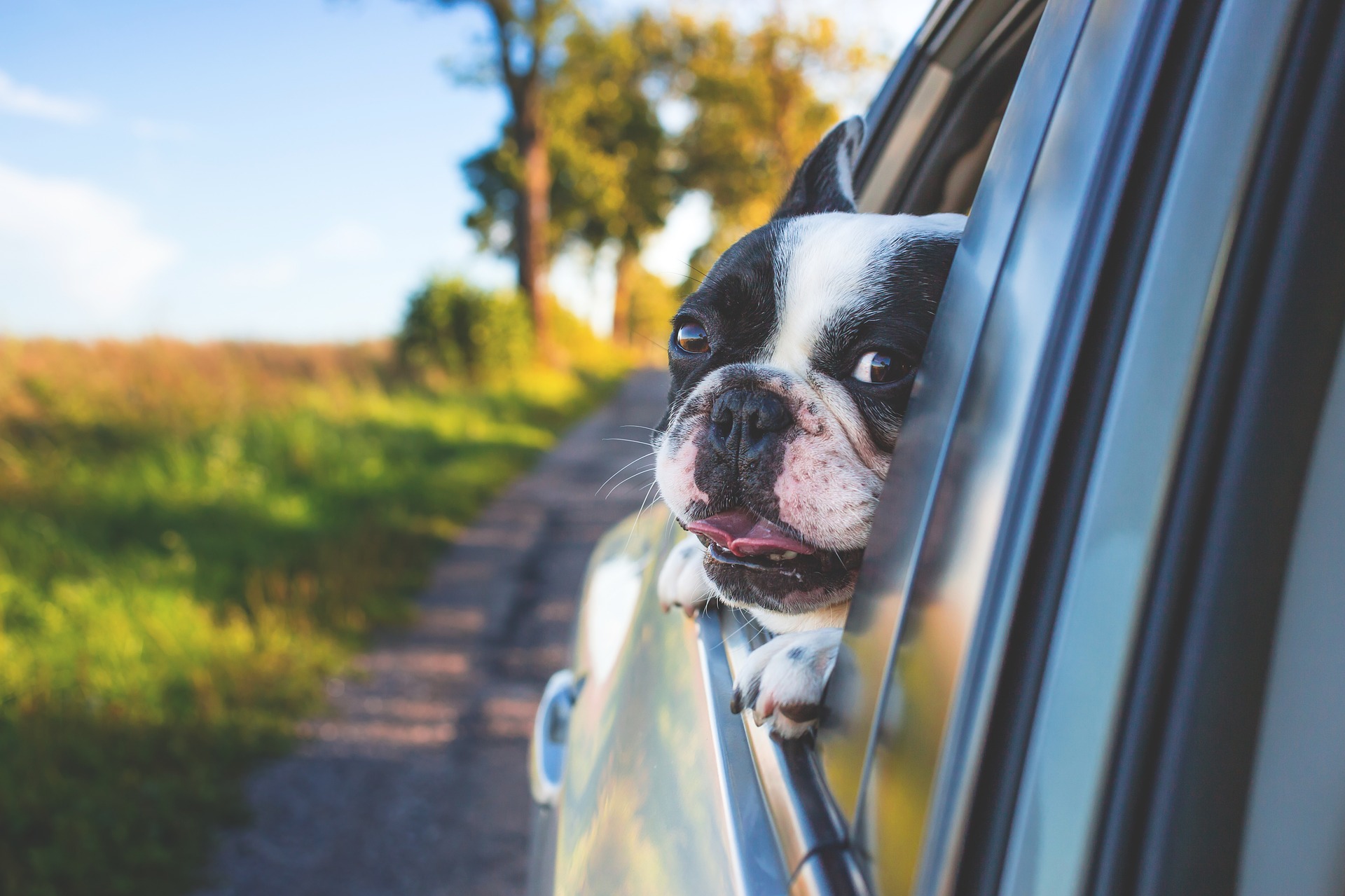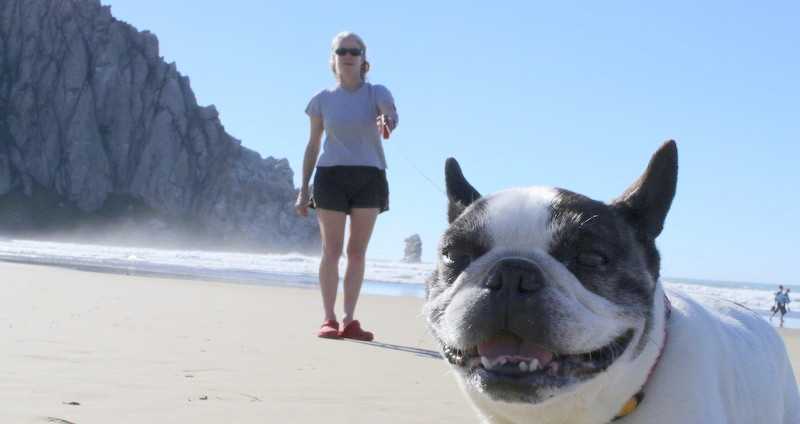Pets and Travel: What to Know Before You Go

Summer is here and people are getting ready to hit the road on much-needed vacations. Pets are often considered to be part of the family, so it’s no surprise many people want to bring their furry friend with them during their travels. Karl Hoopes and Allison Willoughby, faculty in Utah State University’s School of Veterinary Medicine, have some advice for pet owners when it comes to traveling with their animals during the summer.
Both Hoopes and Willoughby, advisor to USU’s Small Animal Specialty Club, agree that one of the most important things owners can do before leaving on a trip is to plan ahead and be aware of the laws at their destinations before they travel. Doing so will make the whole experience more enjoyable for everyone.
“Planning ahead is a must,” Willoughby said. “Keep in mind the activities you are going to be doing and make sure animals are allowed. For example, many national parks allow pets in the car but not on the trail, so you need to check ahead of time.”
It is important to remember that when traveling with pets even the smallest tasks, such as going out to eat or shopping, can become inconvenient and create a problem when pets aren’t allowed in those establishments.
“Traveling with pets can be great for the pet and for people as long as you are prepared for some minor inconveniences,” Willoughby said. “If the whole family works together it can be great.”
Some paperwork also needs to be completed before you hit the road. Most states require a Certificate of Veterinary Inspection (CVI) along with a rabies certificate when crossing state lines. This paperwork is also required when crossing the border into Canada or Mexico. There is always the chance pets will run off in unfamiliar places, so updating their licensing and microchip before leaving is crucial.
Pets can also become more susceptible to illness when traveling. To reduce the risk of pets becoming sick or contracting diseases, Hoopes recommended that all core vaccines be up to date. These vaccines include Bordetella (kennel cough), parvovirus, distemper and adenovirus. If traveling to areas where fleas are present, a flea preventative should be started immediately so that pets don’t pick-up any unwanted creatures.
Hoopes also said it’s a good idea to have the contact information for veterinarians in areas you’ll be visiting saved in a phone so they are already on hand and ready to go.
“You never know if you will have internet service, so it is helpful to already have those numbers with you and in your phone,” Hoopes said. “If an accident happens, you don’t want to spend valuable time looking for numbers. If you already have numbers and addresses, you can take your animals to the clinic immediately.”
On the Road
Beyond the basics of stopping often to let pets go to the bathroom and not leaving them in cars that heat up dangerously fast, Hoopes said one of the biggest problems he sees when traveling with pets in the car is dehydration.
“One of the biggest things is to make sure they don’t get dehydrated. They need water just as often, or even more often, than we do,” Hoopes said. “If it is really hot, dogs love to jump in the water. They love to swim and it really seems to help them.”
Packing water from home can also reduce dehydration risk. Many dogs are simply used to the water they drink at home and refuse to drink anything else. Bringing water from home or packing bottled water is an easy solution to ensure pets stay healthy and hydrated for the duration of the vacation.
Hoopes and Willoughby also recommend that pet owners pack the food their pets are used to eating at home. Any sudden changes to pet’s diet, like a new type of dog food, can have a negative impact and lead to sickness and gastrointestinal problems.
When traveling, pets are placed in new and stressful situations, so it is common for them to have anxiety when traveling. To reduce anxiety, a sedative can be purchased from local veterinarian.
Traveling by Air
Airlines are very particular when it comes to pets as passengers. When traveling by air, pets are typically carried in cargo instead of the passenger cabin. Hoopes said cargo does a good job at taking care of animals, but it is still important to remember that travel always adds additional stress.
“The dog or cat is in a carrier for an extended period of time without interaction. It is stressful and it can be scary,” Hoopes said. “If you do put them in cargo, putting them with a blanket or stuffed toy they are familiar with can help reduce stress.”
Pets traveling by air also require a CVI, and it usually the certificate must have been issued within 72 hours before traveling. Some airlines also require an acclimation statement be included with the certificate. This statement provides the airline with information about the temperature range the animal is acclimated to so that he can be safely transported in cargo. The statement is issued by a veterinarian and must include the temperature range and time frame that is safe for the pet to remain in those temperatures.
Different airlines have different requirements, so it is important to understand what they are beforehand so there are no surprises when it comes time to depart. Owners should ask their
veterinarians to call the airline they’ll be flying with ahead of time to make sure they are prepared to properly take care of animals.
Extra precautions must be taken for airline travel with puppies.
“I hate to send puppies are under 12 weeks old on an airline because it gets really difficult,” Hoopes said. “Make sure they are old enough to travel and that they have been away from their mother long enough to be fully weaned. You don’t want them to be going through the stress of being weaned along with that of traveling.”
Leaving Pets at Home
Traveling with pets can be a great experience, but what should be done when taking them isn’t an option? Should pets be left at home or should they be taken to a kennel? While there are many pros and cons to both options, Hoopes and Willoughby said keeping animals at home with a caregiver is the most ideal.
“The best thing, in my opinion, is to have a dog sitter who will come to your house and take care of them in their own environment,” Hoopes said. “It’s ideal that they stay in their same bed with the same water and food and you just have someone come over to help take care of them.”
Of course, there are still some cases when boarding pets at a kennel is the best option.
“Escape artists might be better in a kennel if you think your dog will run out on your sitter,” Willoughby said. “If your dog sitter won’t be able to be there as much as you typically are and your dog is used to relieving himself several times a day, then a kennel would be preferred. If there are complicated medications to be given, then it would be better to give the kennel the medications unless the sitter is very experienced.”

When it comes to choosing a place to board your pet, it is important to visit kennels ahead of time and think about what each one has to offer in terms of safety, cleanliness and pet care. Hoopes said it is especially important for kennels to offer turnout time as well as individual and group housing options. It needs to be temperature controlled and the kennel should be willing to provide references when asked.
One problem with kennels is it is a place where diseases are often transmitted. Kennel cough is especially common, so pets need to have received the vaccine at least 2-3 weeks ahead of a kennel stay to build up sufficient immunity. Willoughby said this vaccine isn’t long lasting, so it is important to keep it updated. If vaccinated in the spring, immunity should last until the end of summer. Willoughby also recommended that puppies should never be boarded until the entire series of puppy shots is completed because of the risk of infection.
Whenever pets are left home alone, there is always a chance of them developing separation anxiety. Symptoms of separation anxiety include barking and howling, chewing, digging and other destructive behaviors, even if they don’t typically do those things.
“It’s all about fear of the unknown,” Hoopes said. “To reduce this anxiety, get the dog outside and keep the routine the same. Have someone they know coming to take of them and take them for walks.”
Traveling with pets can be a great experience for everyone involved if done correctly. Just remember that for some pets, vacationing may not be their favorite thing.
“Traveling with pets is great. They are a part of the family and it can really add to your vacation,” Hoopes said. “Pets usually do enjoy it, but it is also very individual to the animal. Some pets like it, others don’t. If they don’t like it or won’t handle it well, don’t put them through it.”
Writer: Aubree Thomas, aubree.thomas@usu.edu
Contacts: Karl Hoopes, karl.hoopes@usu.edu Allison Willoughby, allison.willoughby@usu.edu

